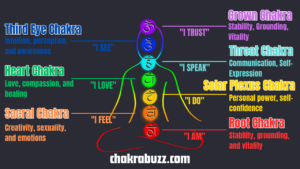The Seven Chakra Chart Made Easy
Chakra Chart

Chakra Chart Infographic
Introduction: What is a Chakra Chart?
A chakra chart is a diagram that represents the seven chakras, or energy centers, in the human body. Chakras are believed to be points of intersection between the physical and spiritual bodies, and they play an important role in holistic health and well-being.
The seven chakras are:
- Root chakra (Muladhara): Located at the base of the spine, the root chakra is associated with the element of earth and the color red. It is believed to be responsible for our sense of security and grounding.
- Sacral chakra (Svadhisthana): Located below the navel, the sacral chakra is associated with the element of water and the color orange. It is believed to be responsible for our creativity and sexuality.
- Solar plexus chakra (Manipura): Located just below the ribcage, the solar plexus chakra is associated with the element of fire and the color yellow. It is believed to be responsible for our personal power and self-confidence.
- Heart chakra (Anahata): Located in the center of the chest, the heart chakra is associated with the element of air and the color green. It is believed to be responsible for our love, compassion, and forgiveness.
- Throat chakra (Visuddha): Located in the throat, the throat chakra is associated with the element of ether and the color blue. It is believed to be responsible for our communication and expression.
- Third eye chakra (Ajna): Located in the center of the forehead, the third eye chakra is associated with the element of light and the color indigo. It is believed to be responsible for our intuition and spiritual awareness.
- Crown chakra (Sahasrara): Located at the top of the head, the crown chakra is associated with the element of consciousness and the color violet. It is believed to be the gateway to our higher self and enlightenment.
Chakras are believed to be interconnected, and they are said to work together to create a balanced and harmonious flow of energy throughout the body. When the chakras are balanced, we are said to experience a sense of well-being, both physically and emotionally. However, when the chakras are imbalanced, we may experience physical or emotional symptoms.
There are a number of ways to balance the chakras, including:
- Meditation: Meditation can help to bring awareness to the chakras and their associated energies.
- Yoga: Yoga poses can help to align the body and mind with the chakras.
- Crystals: Crystals can be used to balance the chakras.
- Aromatherapy: Essential oils can be used to balance the chakras.
- Sound healing: Sound healing can help to balance the chakras.
If you are interested in learning more about chakras, there are a number of resources available online and in libraries. You can also find a number of chakra charts for purchase, both online and in stores.
I hope this blog post was helpful. If you have any other questions, please feel free to ask.
Additional Information
In addition to the seven main chakras, there are also a number of minor chakras located throughout the body. These minor chakras are said to be associated with specific organs or glands.
The chakras are believed to be influenced by our thoughts, emotions, and experiences. When we are stressed or overwhelmed, the chakras can become blocked or imbalanced. This can lead to physical or emotional problems.
There are a number of ways to unblock or balance the chakras. Some common methods include meditation, yoga, and crystal therapy.
- Sri Yantra: Unlocking the Mysteries of Cosmic Harmony
- Incense Waterfall
- How To Unblock Chakras – 10 Simple Methods
- Chakras and Kundalini: the Dance of Energy
- 100 Powerful Shadow Work Prompts
- Joe Dispenza Meditation
- 10 Minute Chakra Meditation
- Your Genetic Wealth Code: The Chakra System and it’s Link to Prosperity
- The Seven Chakra Chart Made Easy
- 50 Crown Chakra Affirmations
- 50 Third Eye Chakra Affirmations
- 50 Throat Chakra Affirmations
